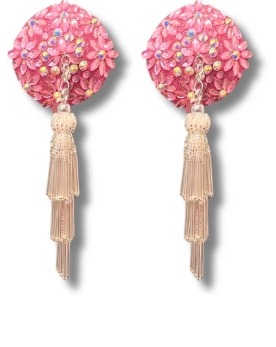Pasties are small adhesive coverings designed to conceal the nipples and are often used as a discreet alternative to traditional bras or under sheer clothing. They come in various styles, fabrics, and shapes, serving both functional and decorative purposes. They offer a seamless way to maintain modesty without the bulk of conventional lingerie, making them popular for both everyday wear and special occasions.
Many choose pasties not just for coverage but also for aesthetics, with options ranging from simple silicone covers to elaborate designs featuring tassels or rhinestones. This versatility allows them to complement lingerie, costumes, or fashion statements with ease. Additionally, premium silicone pasties provide hypoallergenic, sweat-proof, and water-resistant options suited for extended use.
Understanding the practical and stylistic choices behind pasties helps clarify why they remain a favored accessory. Whether for modesty, comfort, or fashion, pasties offer an adaptable solution tailored to individual needs and occasions.
Understanding Pasties Tits
Let’s understand pasties tits. Pasties are adhesive patches designed specifically to cover the nipples and areolae. They serve practical and aesthetic roles, providing coverage under various clothing types or for performance purposes. Their design, history, and material choices vary, reflecting their functional and cultural significance.
Definition and Purpose
Pasties are small, usually circular or decorative patches that cover the nipples and the surrounding areolae. They are self-adhesive or applied with separate adhesives, worn mostly in pairs. Their primary purpose is to provide modesty or coverage when a bra is not suitable or desired.
They are also used to prevent nipple show-through under thin or tight clothing. Additionally, pasties are popular in performance settings, offering a way to appear topless without full exposure. Comfort, discretion, and style are key reasons people choose pasties over traditional undergarments.
Historical Background
Pasties originated in burlesque and exotic dance performances in the early 20th century. They allowed performers to meet decency laws while maintaining the allure of topless dancing. The designs often included tassels and embellishments to add movement and appeal on stage.
Over time, pasties transitioned beyond entertainment. Fashion and everyday wear adopted pasties as a modesty and comfort tool under sheer or revealing outfits. Their evolution reflects changing social attitudes towards body exposure and the demand for diverse undergarment options.
Materials and Styles
Pasties come in several materials: fabric, silicone, latex, and often include adhesive backings. Skin-friendly adhesives are crucial for wearers with sensitive skin to avoid irritation. Some pasties are disposable; others are reusable and easy to clean.
Styles range from simple nude-colored covers to intricate designs featuring sequins, tassels, or shapes. Shapes include circles, hearts, stars, or custom forms to match outfits or personal taste. Choosing the right material and style depends on the occasion, comfort, and aesthetic preference.
Popular Uses and Styling Tips
Pasties serve different purposes depending on the context and outfit. They can be worn for practical reasons like avoiding visible bra lines or purely as a fashion statement. Knowing how to pick pasties and apply them correctly ensures comfort and confidence.
Fashion and Entertainment Applications
Pasties are often used in the fashion industry to create seamless looks under sheer or revealing clothing. Performers and dancers wear them as part of stage costumes, where full coverage is unnecessary or impractical.
Decorative pasties with rhinestones or unique shapes add style elements, making them both functional and eye-catching.
They can be worn under backless dresses, strapless tops, or plunging necklines to prevent nipple visibility without a bra. Many choose pasties for photo shoots or special events where support is secondary to appearance.
How to Choose the Right Pasties
Choosing pasties depends on material, size, and purpose. Silicone pasties are durable, reusable, and provide a natural shape. Paper or fabric disposables are good for one-time use but may lack longevity.
The size should cover the nipple completely without extending too far on the breast to avoid discomfort. Skin tone matching helps mantain discretion. For waterproof or sweat-resistant needs, silicone or specialized sports pasties work best.
Consider adhesive strength in relation to skin type and duration of wear. Some pasties come with added features like breast lift or extra padding.
Application and Removal Techniques
Skin must be clean and dry before applying pasties to ensure proper adhesion. Avoid lotions or oils in the area. Peel the backing gently, then press the pastie firmly against the skin.
Smooth out any edges to avoid peeling or movement. Pasties should be positioned to cover the nipple fully without wrinkling.
For removal, gently peel from the edge. If adhesive residue remains, warm water and mild soap can help remove it without irritation. Proper care extends the life of reusable pasties and maintains skin health.








